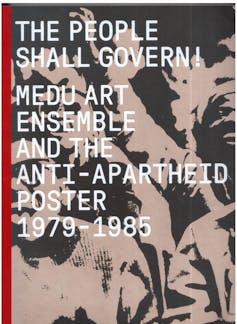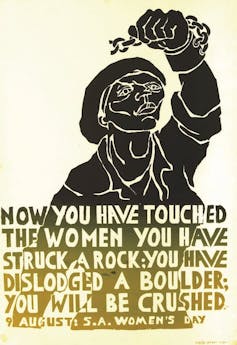Remembering Medu, the South African art collective that fought apartheid
- Judy Seidman
Four decades later, post-apartheid South Africa barely recalls the Medu Art Ensemble's contributions to the liberation struggle. But that could be changing.
The collective was formed by South African cultural activists exiled after the 1976 Soweto uprising and it worked with artists back home, Botswana citizens, and some from other countries. Medu used the creative arts – visual image, theatre, music and literature – to give voice to South Africa’s liberation struggle. In 1982 Medu brought several thousand cultural activists to Gaborone for a conference entitled Culture and Resistance, proclaiming that
Culture is a weapon of Struggle.
A Pan Africanist and anti-colonial enterprise, Medu engaged with international revolutionary art including the work of German theatre-maker Bertolt Brecht, Vietnamese resistance poetry, the Mexican mural painters and Chile’s muralists who spoke back to dictatorship.
On 14 June 1985 the South African military targeted Medu members in Botswana in a cross-border raid. They killed 14 people and destroyed the art-making collective.
Almost lost to history
Four decades later, post-apartheid South Africa barely recalls Medu’s contributions. All that’s been remembered until now have been Medu’s iconic posters (“Smash Bantu Education”, “You have touched a rock”, “The people shall govern”) and the individual creative work of celebrated Medu writers Keorapetse Kgositsile, Mongane Wally Serote and Mandla Langa. Of musicians Jonas Gwangwa and Dennis Mpale. Of visual artist Thamsanqa Mnyele.
But what’s been lacking is a record of the intense debates, contested cultural theory, collective understanding and shared perceptions that infused these works.
In 2019 a breakthrough came when the Art Institute of Chicago collected and displayed Medu’s posters. This was followed by a book in the form of a catalogue entitled The People Shall Govern: Medu Art Ensemble and the Anti-apartheid Poster 1979-1985.
Here, as an artist who was a member of Medu, I offer a critical perspective on the narrative that emerges from this exhibition and catalogue.
The Chicago show
Doubts inevitably arise when African artworks are displayed in art institutions in foreign metropoles, far from the communities and struggles that birthed them. In Medu we believed our work must inspire resistance and envisage future liberation. What do these posters say to viewers when hung on sterile gallery walls in Chicago or London?

The curators of the Medu exhibit were Antawan Byrd and Felicia Mings, who previously researched Pan Africanist cultural struggles and took these challenges seriously.
As no broad narrative or comprehensive collection of Medu’s work exists, they contacted surviving Medu members, unearthed hidden histories and sought out post-apartheid cultural discourse. They wrote texts for the gallery walls and displayed paraphernalia that included magazines like 足球竞彩app排名rider and The African Communist, political buttons, T-shirts, music and film clips. They organised public lectures and discussions.
The catalogue
The catalogue was published a year after the exhibition closed. Without the show’s objects and framing activities, the text weaves a narrative about Medu through seven essays, juxtaposed with poster images.
The catalogue arranges posters by theme: political resistance, music, women’s struggles, June 16th 1976, workers, and struggle heroes. This foregrounds imagery and slogans over creative interpretation and vision. Clenched fists read as cliché or symbol, rather than lived experience of the struggle. Posters for murdered comrades become “heroic depictions of activists and freedom fighters”, not cherished memories of real people.
In the text, a brief overview of Medu’s history is followed by South African poet laureate Mongane Serote’s own experience of shaping Medu as a cultural project of the exiled ANC. While this story forms a core part of Medu’s history, it skips over other contributions to Medu’s dynamic mix. Like vibrant debates with Black Consciousness-aligned cultural activists in Gaborone, Medu members’ underground work with the ANC’s military wing, and cross-fertilisation with groups creating struggle art inside South Africa.
Ming and Byrd discuss the aesthetics of Medu graphics, finding similarities with early Soviet art. But Medu consciously traced its aesthetic roots to Pan Africanist and African diasporic cultural theory and practice. We looked to social philosopher Frantz Fanon and African writers Wole Soyinka and Ng?g? wa Thiong'o. To pre-colonial and anti-colonial African art. To the art of Mozambique’s Malangatana Ngwenya and South Africa’s Dumile Feni.

A chapter from South African curator Khwezi Gule views Medu through the cultural gaze of post-1990 South Africa. Gule maintains that Medu’s slogan, “art is a weapon of struggle”, has been “reduced to a blunt tool for propaganda”. He argues that “weaponising art degenerates into crass sloganeering” as artistic vision buckled under ANC compromises, white privilege and the commercial art market. Gule concludes today’s generation must fashion their own, different, rebellious culture.
By contrast, South African author and scholar Ashraf Jamal holds that Medu’s democratic discourse and praxis bred hope and belief, emerging from and inspiring Southern Africa’s liberation struggle. He concludes that “Medu’s struggle cannot be solely framed through its historical placement in the 1970s and 1980s. The idea and spirit that inform it also predate and exceed it.”
The final essay, Collecting the Posters, by South African collector and gallerist Warren Siebrits, gives yet another perspective. Siebrits was conscripted into the apartheid army in 1988 and deployed to military intelligence: “One of our unit’s main tasks was to destroy ‘subversive enemy propaganda posters’.” After 1994, he hunted these now rare posters to place them into today’s art world “by purchase from private collections and book dealers and while travelling to Botswana”. He does not explain that these posters were personal copies saved by Medu member Marius Schoon, whose wife Jeannette Curtis Schoon and 6-year-old daughter Katryn were killed by a 1984 letter bomb in Angola. Siebrits bought the posters from their surviving son, exhibiting them in his Johannesburg gallery before donating them to the Art Institute of Chicago. This traumatic history of the posters speaks sharply to Medu’s meaning then and now.
The catalogue and the exhibition aim to provide and prompt “new scholarship on Medu’s courageous and consequential work”. The first steps towards reclaiming Medu’s legacy have been taken.
There is still a long road ahead.![]()
Judy Seidman, Research associate, History Workshop, University of the Witwatersrand. This article is republished from The Conversation under a Creative Commons license. Read the original article.

